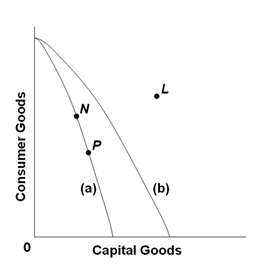Refer to the production possibilities curves below. Curve (a) is the current curve for the economy. Focusing on curve (a), point N suggests that the economy currently produces:

A. More goods for the future than at point P
B. Less goods for the future than at point P
C. Less goods for the present than at point P
D. A combination of output that is less than its potential
Answer: B
You might also like to view...
Utils are used by economists to measure the satisfaction a person obtains from consuming a good
a. True b. False Indicate whether the statement is true or false
Consider a firm operating in a perfectly competitive market. At its current output of 200 units, marginal revenue is $28 . At this output, average total cost is minimized and equals $25 . Given this information, what should the firm do?
a. Continue to produce 200 units, since costs per unit are minimized b. Increase output beyond 200 units, since this higher output will yield the profit maximizing output level. c. Decrease output below 200 units, since this lower output will result in the profit maximizing output level. d. More information is needed to determine the firm's next step.
Choose the incorrect statement.
A) When the quality of a good improves over time and as a result the price rises, the CPI counts the entire price rise as inflation and so overstates inflation. B) The outlet substitution bias injects an upward bias into the CPI. C) The CPI basket is constantly updated to allow for the introduction of new goods. D) When relative prices change and people substitute to the lower priced good, the CPI ignores the substitution and the CPI overstates inflation. E) All of the above statements are incorrect. C) The CPI basket is constantly updated to allow for the introduction of new goods.
Assume the wool industry is perfectly competitive. The market demand curve for wool is ________ and each individual wool producer's demand curve is ________.
A. horizontal; horizontal B. downward sloping; downward sloping C. downward sloping; horizontal D. horizontal; downward sloping